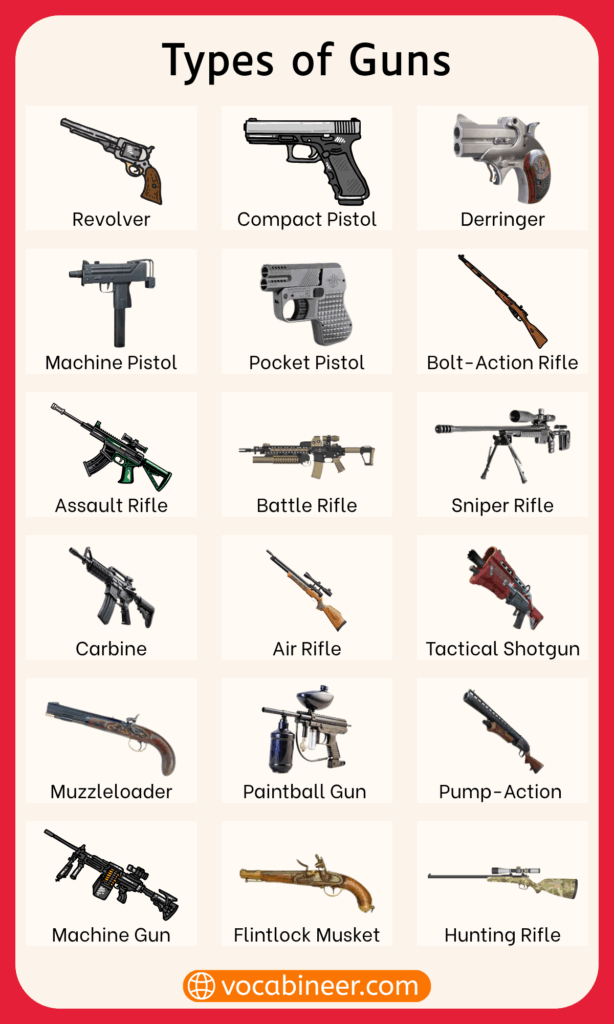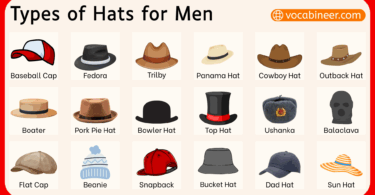Guns are tools designed to fire bullets using a forceful release of energy, often from burning powder. Each type has a specific design, shooting action, and purpose, ranging from self-defense to sport or law enforcement. Some guns are built for close range, others for long distance, and some for rapid firing or high accuracy. This post helps you learn the different types of guns with their pictures. It explains gun names used in hunting, defense, policing, and firearm education.
In This Page
Common Types of Handguns
Handguns are compact firearms designed for one-handed use. They’re widely used in law enforcement, self-defense, sport shooting, and military service. Here’s a breakdown of the most common handgun types based on their build, function, and usage.
Revolvers
Feature a rotating cylinder that holds multiple rounds, usually 5 to 7. Known for simplicity and reliability.
- Colt Python
- Smith & Wesson Model 686
- Ruger LCR
Semi-Automatic Pistols
Use recoil or gas to automatically cycle the next round. They have removable magazines and faster reload times.
- Glock 19
- Sig Sauer P320
- Beretta 92FS
Compact Pistols
Smaller versions of standard handguns, easier to conceal and carry.
- Glock 43
- Smith & Wesson M&P Shield
- Springfield Hellcat
Subcompact Pistols
Even smaller than compact models, made for deep concealment or backup use.
- Ruger LCP Max
- Sig Sauer P365
- Kimber Micro 9
Single-Shot Pistols
Fire only one round at a time; mostly used for hunting or target shooting.
- Thompson Center Contender
- Bond Arms Derringer
- Traditions Crackshot
Derringers
Ultra-small, pocket-sized pistols that usually hold one or two rounds.
- Remington Model 95
- Bond Arms Backup
- Cobra Big Bore
Machine Pistols
Capable of fully automatic fire, often compact and used in military or special forces roles.
- Glock 18
- Beretta 93R
- Stechkin APS

Shotgun Types and Their Uses
Shotguns are versatile firearms that fire shells containing multiple pellets or slugs. They’re commonly used in hunting, sport shooting, home defense, and law enforcement. Below are the main types of shotguns with practical use cases.
Pump-Action Shotguns
Manually cycled by sliding the fore-end. Reliable, affordable, and widely used for defense and hunting.
Uses: Home defense, deer hunting, tactical applications
- Remington 870
- Mossberg 500
- Winchester SXP
Break-Action Shotguns
Feature a hinged barrel design that opens to load shells. Often seen in double-barrel forms.
Uses: Skeet shooting, clay sports, bird hunting
- Browning Citori
- Stoeger Coach Gun
- Beretta Silver Pigeon
Semi-Automatic Shotguns
Automatically chambers the next shell using gas or recoil. Allows faster follow-up shots.
Uses: Duck hunting, 3-gun competition, tactical response
- Benelli M4
- Beretta A400
- Mossberg 940 Pro
Single-Shot Shotguns
Fires one shell at a time. Lightweight and easy to operate.
Uses: Beginner shooting, small game hunting
- H&R Pardner
- Rossi Single Shot
- Savage 301
Bolt-Action Shotguns
Manually operated with a bolt handle. Rare but precise.
Uses: Specialty slug hunting, states with firearm restrictions
- Mossberg 695
- Marlin Model 512
- Savage 210
Lever-Action Shotguns
Use a lever to cycle shells. Less common, but favored for style and cowboy action shooting.
Uses: Cowboy action shooting, small game hunting
- Winchester Model 1887
- Chiappa 1887
- Henry Lever Action .410
Tactical Shotguns
Built for defense or law enforcement, often outfitted with rails, extended tubes, or pistol grips.
Uses: Home defense, police and military operations
- Benelli M4 Tactical
- Remington 870 Tactical
- Kel-Tec KSG
Overview of Machine Guns
Machine guns are fully automatic firearms capable of sustained fire while the trigger is held. Unlike semi-automatic guns, they continue firing as long as ammunition and power are available. They are primarily used by military and security forces due to their high rate of fire and area suppression capability.
Light Machine Guns (LMGs)
Portable and often used by individual soldiers to provide suppressive fire. Usually belt-fed or magazine-fed.
Common uses: Squad support, mobile firepower, battlefield suppression
- M249 SAW
- FN Minimi
- RPK
Medium Machine Guns (MMGs)
Heavier than LMGs, typically mounted or tripod-supported. Fires full-power rifle cartridges.
Common uses: Defensive positions, vehicle mounts, long-range sustained fire
- M240B
- PKM
- MG3
Heavy Machine Guns (HMGs)
Designed for maximum damage, usually firing large-caliber rounds (.50 BMG or similar). Always mounted.
Common uses: Anti-vehicle roles, aircraft defense, fortification suppression
- Browning M2
- DShK
- NSV
General-Purpose Machine Guns (GPMGs)
Versatile guns that can serve as both LMGs and MMGs based on configuration.
Common uses: Infantry support, vehicle-mounted fire, bipod or tripod use
- MG42
- FN MAG
- PKP Pecheneg
Submachine Guns vs. Machine Guns
Although similar in automatic fire, submachine guns fire pistol-caliber rounds and are not classified as true machine guns due to lower power and limited range.
Submachine Guns and PDWs Explained
Submachine guns and personal defense weapons (PDWs) are compact automatic firearms that fire pistol-caliber or low-recoil rounds. They’re designed for close-quarters combat, making them popular among military, law enforcement, and security units.
Submachine Guns (SMGs)
Submachine guns are fully automatic firearms that shoot pistol-caliber ammunition. They’re lightweight, easy to control, and ideal for short-range use.
Common roles: Urban combat, VIP protection, special operations
- Heckler & Koch MP5
- Uzi
- CZ Scorpion EVO 3
- MAC-10
- MP40
Personal Defense Weapons (PDWs)
PDWs are similar to SMGs but usually fire high-velocity, low-recoil rounds designed to penetrate body armor. They bridge the gap between pistols and rifles.
Common roles: Vehicle crews, support troops, special units
- FN P90
- Heckler & Koch MP7
- SIG Sauer MPX
- B&T MP9
- LWRC SMG-45
Key Differences
- Caliber: SMGs use standard pistol rounds; PDWs often use specialized ammunition
- Armor Penetration: PDWs can pierce light body armor; SMGs usually cannot
- Design Purpose: SMGs are older tech; PDWs are modern solutions for compact firepower with more reach
Sniper Rifles and Long-Range Firearms
Sniper rifles and other long-range firearms are built for extreme accuracy over long distances. They’re used for precision targeting in military, law enforcement, and sport shooting roles. These guns often feature specialized optics, heavy barrels, and powerful cartridges.
Bolt-Action Sniper Rifles
Highly accurate and reliable, these require manual cycling between shots. Often preferred for extreme precision.
Used in: Military marksman roles, competition shooting
- Remington 700
- Accuracy International AXMC
- Tikka T3x TAC A1
- Mosin-Nagant
- Ruger Precision Rifle
Semi-Automatic Sniper Rifles
Allow faster follow-up shots without sacrificing much precision. Heavier and more complex than bolt-action types.
Used in: Tactical missions, police sniping, DMR roles
- M110 SASS
- Dragunov SVD
- FN SCAR 20S
- AR-10
- Heckler & Koch PSG1
Anti-Materiel Rifles
These fire very large-caliber rounds designed to disable equipment or vehicles, not just personnel.
Used in: Long-range hard target engagement, military ops
- Barrett M82
- McMillan TAC-50
- Denel NTW-20
- Accuracy International AS50
Designated Marksman Rifles (DMRs)
Bridge the gap between assault rifles and sniper rifles. Semi-auto, with enhanced optics and accuracy.
Used in: Infantry squads for extended reach
- M14 EBR
- HK417
- SR-25
- FN FAL DMR variant
Historic and Antique Guns
Historic and antique guns represent early firearm technology and craftsmanship. These weapons are no longer used in modern combat but are prized by collectors, historians, and museums for their design, historical value, and influence on modern firearms.
Flintlock Firearms
Used a flint striking mechanism to ignite powder. Common from the 1600s to early 1800s.
Famous models:
- Brown Bess Musket
- Charleville Musket
- Kentucky Flintlock Rifle
Percussion Cap Firearms
Replaced flint with a percussion cap system for more reliable ignition. Dominated the mid-1800s.
Famous models:
- Colt 1851 Navy Revolver
- Springfield Model 1861
- Enfield P1853 Rifle
Matchlock Firearms
Among the earliest guns, used a lit match to ignite powder. Slow and weather-sensitive.
Famous models:
- Japanese Tanegashima
- European Arquebus
- Indian Toradar
Early Revolvers
Introduced rotating cylinders and faster reloading in the 19th century.
Famous models:
- Colt Paterson
- Colt Walker
- Adams Revolver
Civil War-Era Rifles
Rifled barrels and percussion systems gave higher accuracy.
Famous models:
- Sharps Rifle
- Spencer Repeating Rifle
- Henry Rifle
Vintage Lever-Action Guns
Predecessors to modern repeating rifles, used in the Old West.
Famous models:
- Winchester Model 1873
- Marlin Model 1881
- Evans Repeating Rifle
Non-Lethal and Training Guns
Non-lethal and training guns are used for practice, crowd control, or law enforcement situations where deadly force isn’t intended. These firearms or firearm-like tools help build skills, ensure safety, or handle threats without causing fatal injury.
Airsoft Guns
Replicas that shoot plastic BBs using compressed air or gas. Used in tactical training and recreational games.
Common types:
- Airsoft Glock 17
- M4 Airsoft Rifle
- H&K MP5 Airsoft
Paintball Guns (Markers)
Shoot paint-filled pellets for sport and simulation. Often used in scenario training.
Common types:
- Tippmann 98 Custom
- Planet Eclipse Etha
- Spyder MR100
Blank-Firing Guns
Realistic firearms that fire only blanks. Often used in movies, drills, or ceremonial events.
Common types:
- Zoraki 925
- Bruni Olympic 6
- Retay S2022
Rubber Bullet Guns
Used by law enforcement for riot control or crowd dispersion. Less lethal but can still cause injury.
Common types:
- FN 303 Launcher
- Penn Arms 40mm Revolver Launcher
- Milkor MGL firing rubber rounds
Training Pistols
Designed for safe, repeated practice. Often solid-color, weighted, and non-firing.
Common types:
- Glock Bluegun
- SIRT Training Pistol
- ASP Red Gun
Stun Guns and Tasers
Deliver electric shocks to incapacitate without lasting harm. Often carried for personal defense.
Common types:
- Taser X2
- Taser Pulse
- Vipertek VTS-989
Guns by Role and Application
Firearms are built for different roles depending on the task, user, and environment. Whether for defense, hunting, sport, or military use, each category suits specific operational needs. Below are the common gun types based on their practical application.
Self-Defense Guns
Compact, easy to carry, and quick to draw in emergencies.
Common choices:
- Glock 43X (pistol)
- Smith & Wesson M&P Shield
- Taurus G3C
- Ruger LCP Max
Law Enforcement Guns
Reliable firearms selected for duty use, crowd control, or tactical raids.
Common choices:
- Glock 17 (sidearm)
- Remington 870 (shotgun)
- Colt M4 Carbine (rifle)
- Taser X2 (non-lethal)
Military Guns
Built for durability, automatic fire, and performance in extreme conditions.
Common choices:
- M16A4
- FN SCAR-H
- M249 SAW
- Barrett M82
Hunting Guns
Designed for accuracy, range, and stopping power suitable for different game.
Common choices:
- Remington 700 (rifle)
- Mossberg 500 (shotgun)
- Henry Lever Action .30-30
- Tikka T3x
Competition and Sport Shooting Guns
Tuned for precision, balance, and speed in matches or target ranges.
Common choices:
- CZ Shadow 2 (pistol)
- Walther PPQ Q5 Match
- Ruger 10/22
- Benelli SuperSport (shotgun)
Home Defense Guns
Chosen for short-range power, maneuverability, and ease of use under stress.
Common choices:
- Mossberg 590 (shotgun)
- AR-15 pistol
- Glock 19
- Kel-Tec KSG
Survival and Prepper Guns
Versatile firearms for long-term sustainability, small game hunting, and self-defense.
Common choices:
- Ruger 10/22 Takedown
- Savage Model 42
- AR-7 Survival Rifle
- Smith & Wesson Model 60
Firearm Types by Firing Mechanism
Different guns use various firing mechanisms to ignite the cartridge and fire a round. These mechanisms affect how fast the firearm shoots, how it’s loaded, and how reliable it is in different conditions. Here’s a breakdown of the main types:
Single-Shot Firearms
Fires one round at a time; must be reloaded after each shot.
- Break-action rifle
- Single-shot shotgun
- Thompson Center Contender
Bolt-Action Firearms
Manually operated bolt loads and ejects cartridges; known for accuracy.
- Remington 700
- Mosin-Nagant
- Mauser 98
Lever-Action Firearms
Lever beneath the trigger loads the next round; classic Western style.
- Winchester Model 94
- Marlin 336
- Henry Big Boy
Pump-Action Firearms
Fore-end is pumped to chamber the next shell and eject the spent one.
- Remington 870
- Mossberg 500
- Winchester Model 12
Semi-Automatic Firearms
Fires one round per trigger pull and auto-loads the next.
- AR-15
- Glock 17
- Beretta M9
Fully Automatic Firearms
Continuously fires while the trigger is held.
- M249 SAW
- M60
- Heckler & Koch MG4
Select-Fire Firearms
Switchable firing modes: semi-auto, burst, or full-auto.
- M16
- FN SCAR
- AK-12
Revolving Firearms
Rotating cylinder aligns rounds with the barrel.
- Colt Python
- Smith & Wesson Model 686
- Ruger GP100
Break-Action Firearms
Hinges open to load shells manually; often side-by-side or over-under.
- Stoeger Coach Gun
- Browning Citori
- Savage 301
Blowback-Operated Firearms
Simple design using recoil to cycle the action.
- Walther PPK
- MAC-10
- Hi-Point C9
FAQs about Different Types of Guns
The main types of guns include handguns, rifles, shotguns, machine guns, submachine guns, and sniper rifles. Each has a specific use.
A rifle fires single bullets through a rifled barrel. A shotgun fires shells with pellets or slugs and often spreads the shot.
Semi-automatic guns fire one bullet per trigger pull. Automatic guns keep firing as long as the trigger is held.
No. BB guns fire metal balls, while air guns may shoot pellets or darts. Both use compressed air but have different ammo.
Less-lethal guns like rubber bullet launchers and paintball markers are used in training, games, or riot control—not for killing.
Read More




